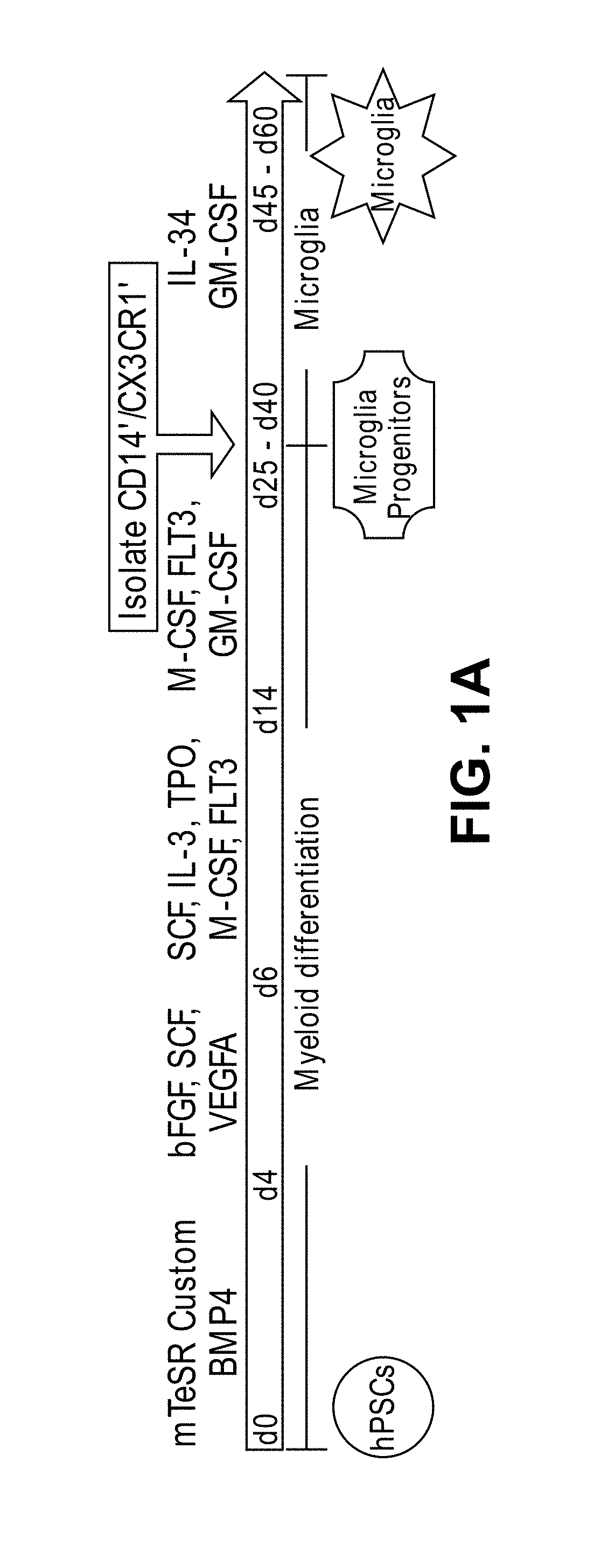Microglia derived from pluripotent stem cells and methods of making and using the same
- Summary
- Abstract
- Description
- Claims
- Application Information
AI Technical Summary
Benefits of technology
Problems solved by technology
Method used
Image
Examples
example 1
n of Microglia from Human Pluripotent Stem Cells
[0072]As microglia cells arise from myeloid progenitors in the yolk sack during embryonic development, we sought to establish a serum- and feeder-free protocol to differentiate human PSCs towards the myeloid lineage. The protocol that we generated is illustrated in schematic form in FIG. 1A). Building upon previous studies (Yanagimachi et al., 2013), we induced primitive streak-like cells through BMP4 signaling, obtaining a KDR+CD235a+ population of primitive hemangioblasts (Sturgeon et al., 2014) (Figure S1A). CD45+CX3CR1− microglial progenitors appeared in the supernatant fraction of the culture by day 16, while CX3CR1 was upregulated between day 20 and 25. In contrast, the adherent population contained only a small fraction of CD45+CX3CR1+ progenitors. Interestingly, a subset of the CD45+CX3CR1− population upregulated CD14 around day 16, before the upregulation of CX3CR1 (FIG. 1B). Between day 25 and day 50, 82±5% of the CD14+ cells...
example 2 — experimental procedures
Example 2—Experimental Procedures
[0093]This Example provides details regarding the materials and methods used to perform the studies outlined in Example 1.
[0094]Pluripotent Stem Cell Lines
[0095]Two human ESC lines (RUES1 and H9, both NIH approved) and 15 iPSC lines were used in this study; these lines are described in the Supplemental Information. One iPSC line was a gift from Dr. Ricardo Feldman and all other iPSC lines were reprogrammed at the NYSCF Research Institute. Human primary microglia and hepatic macrophages were purchased from ScienCell Research Laboratories.
[0096]Microglial Differentiation Protocol
[0097]PSCs differentiation was induced with mTeSR Custom medium (StemCell Technologies), containing 80 ng / ml BMP4. At day 4 cells were induced with 25 ng / ml bFGF, 100 ng / ml SCF and 80 ng / ml VEGF in StemPro-34 SFM (with 2 mM GutaMAX, Life Technologies). Two days later, the medium was supplemented with 50 ng / ml SCF, 50 ng / ml IL-3, 5 ng / ml TPO, 50 ng / ml M-CSF and 50 ng / ml Flt3 and...
example 3
[0130]Alternative Protocols for the Generation of Microglia from Pluripotent Stem Cells
[0131]This example provides alternative exemplary protocols for the generation of microglia from pluripotent stem cells. In these protocols, CD14+ / CX3CR1+ microglial progenitors are isolated via FACS, or based on only CD14 expression using magnetic bead-based isolation, and the isolated CD14+ progenitors are then plated onto tissue culture treated plastic in either an alternative (“A”) microglial differentiation medium (comprising M-CSF, GM-CSF, NGF-β and CCL2), or in a regular (“R”) microglial differentiation medium (comprising GM-CSF and IL-34, as used in the Examples 1 and 2). Except where stated otherwise, the materials and methods for this Example are the same as those described above for Examples 1 and 2.
[0132]In one exemplary protocol, the following steps are performed on the indicated days:
[0133]Day 0: Induce undifferentiated iPSC colonies grown onto Matrigel (roughly 1 mm in diameter) by ...
PUM
 Login to View More
Login to View More Abstract
Description
Claims
Application Information
 Login to View More
Login to View More - R&D
- Intellectual Property
- Life Sciences
- Materials
- Tech Scout
- Unparalleled Data Quality
- Higher Quality Content
- 60% Fewer Hallucinations
Browse by: Latest US Patents, China's latest patents, Technical Efficacy Thesaurus, Application Domain, Technology Topic, Popular Technical Reports.
© 2025 PatSnap. All rights reserved.Legal|Privacy policy|Modern Slavery Act Transparency Statement|Sitemap|About US| Contact US: help@patsnap.com



